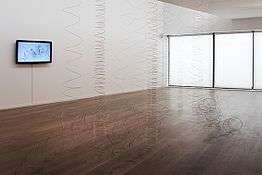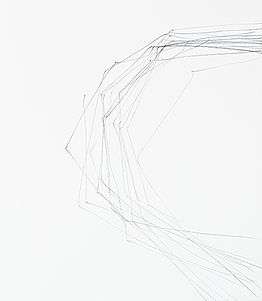Marie Hanlon
In 2015 Marie Hanlon was elected as a member of Aosdána, the cultural body which recognises major and sustained contribution to the arts in Ireland. Hanlon is almost unique among contemporary Irish artists for the extent of her engagement with contemporary music. She has collaborated as co-equal with Irish composers, most notably Rhona Clarke, in creating works that may encompass music, installation and video.
Marie Hanlon | |
|---|---|
 Portrait of Marie Hanlon | |
| Born | December 20, 1948 Goresbridge, Co. Kilkenny |
| Nationality | Irish |
| Education | University College, Dublin |
Hanlon grew up in the village of Goresbridge on the banks of the River Barrow in County Kilkenny, Ireland. She was the only daughter of eight children born to Margaret and Thomas Hanlon. Following a primary and secondary education in Goresbridge she studied History of European Painting and English at University College, Dublin, graduating in 1977. While at UCD she was awarded a Dr. Henry Hutchinson Stewart Literary Scholarship from the National University of Ireland.
Artistic practice


Hanlon drew on the form and structure of literary works when, later, she turned her attention to painting. In 1988 she became a member of WAAG – Women Artists Action Group (1987–1991). She exhibited with the group in their first and only show in Ireland, Art Beyond Barriers at the Irish Museum of Modern Art in 1989 (Cummins, 1989).[1] Hanlon's first solo show was in Temple Bar Gallery in 1993. By now her works had begun to demonstrate a stylistic approach which is simultaneously geometric and lyrical, their reduced elements tautly balanced and “characteristically subtle in the handling of tone, texture and composition.” (Finlay, 1997) [2] “The paintings are like poems or pieces of music, at once tentative and sensual, yet highly structured.” (Benson, 2004) [3]
- “Forms are repeated in the paintings but rarely in exactly the same way. It is the repetition which gives the work its rhythm, a kind of pulse is established by stating and restating the idea. However, as soon as a pattern is set up it is quickly subverted and transformed, the beat changes as it were, giving the work greater complexity and interest.” (Clarke, 2009) [4]
Critic Gavin Weston has described “works that are paradoxically structurally contained yet emotionally expansive.” (Weston, 2004) [5]
Stated influences include Robert Ryman, Agnes Martin and Ellsworth Kelly (Sam, 2009–2010).[6]
In recent years Hanlon's output has encompassed a broad range of media, with new works in installation and video. A prime example is her large-scale show Everything We See at Solstice Arts Centre in 2014. It included video, installation and sound works. DIC TAT at Draíocht Centre for the Arts in the same year was similarly rich in media, but also featured direct linking of drawing and music, where pieces were created in time to a metronome.
References
- Cummins, Pauline (Ed.) (1989). WAAG: Art Beyond Barriers. Dublin, Ireland: WAAG Publications.CS1 maint: extra text: authors list (link)
- Finlay, Sarah (1997). Landscape & Recollection: The Ballinglen Experience. Dublin: RHA Gallery Trus. pp. 36–37. ISBN 1902168003.
- Benson, Ciarán (2004). In the Time of Shaking. Dublin: Art for Amnesty. ISBN 9780954725808.
- Clarke, Rhona (2009). Éigse. Carlow: Éigse Carlow Arts Festival.
- Weston, Gavin (Spring 2004). "Belfast: Colourchart at Ormeau Baths and John Kingerlee at Taylor Gallery". Circa (107). Retrieved 2015-11-08.
- Sam, Sherman (2009–2010). Marie Hanlon: Walk with me, dance with me. Dublin: The Rubicon Gallery. p. 16. ISBN 9780956545312.